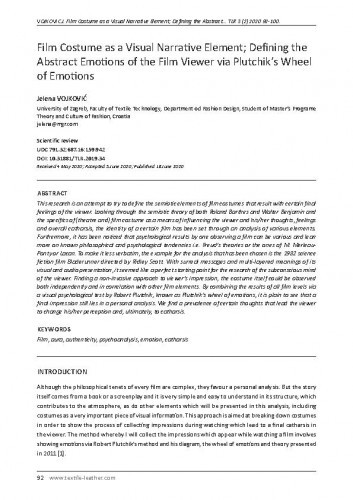This research is an attempt to try to define the semiotic elements of film costumes that result with certain final feelings of the viewer. Looking through the semiotic theory of both Roland Barthes and Walter Benjamin and the specifics of (theatre and) film costume as a means of influencing the viewer and his/her thoughts, feelings and overall catharsis, the identity of a certain film has been set through an analysis of various elements. Furthermore, it has been noticed that psychological results by one observing a film can be various and lean more on known philosophical and psychological tendencies i.e. Freud’s theories or the ones of M. Merleau-Ponty or Lacan. To make it less verbatim, the example for the analysis that has been chosen is the 1982 science fiction film Bladerunner directed by Ridley Scott. With surreal messages and multi-layered meanings of its visual and audio presentation, it seemed like a perfect starting point for the research of the subconscious mind of the viewer. Finding a non-invasive approach to viewer’s impression, the costume itself could be observed both independently and in correlation with other film elements. By combining the results of all film levels via a visual psychological test by Robert Plutchik, known as Plutchik’s wheel of emotions, it is plain to see that a final impression still lies in a personal analysis. We find a prevalence of certain thoughts that lead the viewer to change his/her perception and, ultimately, to catharsis.
Sažetak

 Textile & leather review : 3,2(2020) / editor-in-chief Dragana Kopitar.
Textile & leather review : 3,2(2020) / editor-in-chief Dragana Kopitar.